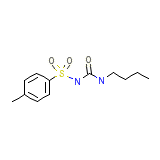Aglicid




Aglicid Brand names, Aglicid Analogs
- Aglicid
- Apo-Tolbutamide
- Arkozal
- Artosin
- Artozin
- Butamid
- Butamide
- Diaben
- Diabetamid
- Diabetol
- Diabuton
- Diasulfon
- Dirastan
- Dolipol
- Drabet
- Glyconon
- Ipoglicone
- Mobenol
- Novo-Butamide
- Orabet
- Oralin
- Orezan
- Orinase
- Orinase Diagnostic
- Orinaz
- Oterben
- Pramidex
- Rastinon
- Restinon
- Sk-tolbutamide
- Tol-Tab
- Tolbusal
- Tolbutamid
- Toluina
- Tolumid
- Toluvan
- Tolylsulfonylbutylurea
- Willbutamide
Aglicid Brand Names Mixture
- No information avaliable
Aglicid Chemical_Formula
C12H18N2O3S
Aglicid RX_link
No information avaliable
Aglicid fda sheet
Aglicid msds (material safety sheet)
Aglicid Synthesis Reference
No information avaliable
Aglicid Molecular Weight
270.349 g/mol
Aglicid Melting Point
128.5 oC
Aglicid H2O Solubility
109 mg/L
Aglicid State
Solid
Aglicid LogP
2.765
Aglicid Dosage Forms
Tablet (250 and 500 mg)
Aglicid Indication
Used as an oral hypoglycemic agent in non-insulin-dependent (type 2) Diabetes Miletus with adult onset.
Aglicid Pharmacology
Tolbutamide, a second-generation sulfonylurea antidiabetic agent, is used with diet to lower blood glucose levels in patients with diabetes mellitus type II. Tolbutamide is twice as potent as the related second-generation agent glipizide. Tolbutamide lowers blood sugar by stimulating the pancreas to secrete insulin and helping the body use insulin efficiently. The pancreas must be able to produce insulin for this drug to work.
Aglicid Absorption
Well absorbed. Absorption is unaltered if taken with food but is increased with high pH.
Aglicid side effects and Toxicity
Oral, mouse: LD50 = 2600 mg/kg
Aglicid Patient Information
Treatment with tolbutamide may increase the risk of death from cardiovascular disease compared to treatment of diabetes with diet alone or diet plus insulin. Discuss with your doctor the risks and benefits of treatment with tolbutamide. Know the signs and symptoms of low blood sugar (hypoglycemia), which include headache, drowsiness, weakness, dizziness, fast heartbeat, sweating, tremor, and nausea. Carry a piece of hard candy or glucose tablets with you to treat episodes of low blood sugar. Follow your diet, medication, and exercise routines closely. Changing any of them can affect blood sugar levels. Do not change your dose of tolbutamide without first talking to your doctor. Avoid alcohol. It lowers blood sugar and may interfere with your diabetes treatment.
Aglicid Organisms Affected
Humans and other mammals














